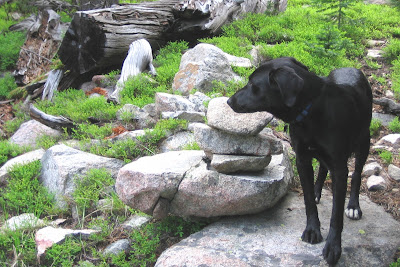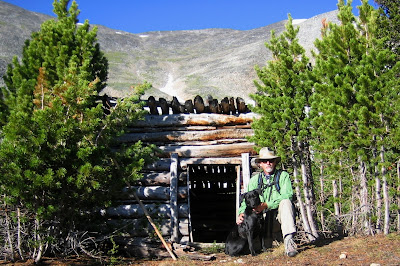
The Trek
Friend Dave Carter had some chores at home (Hey, aren't you supposed to be retired?), so MollyTheDog (MTD) & I set out on a solo trip. Weather was perfect for the long hike (and climb, beginning at c. 5500 feet) in, cool and a bit rainy, with Mt Haggin closed in by weather:

Much of the trail in is along an old maintenance road to Hearst Lake, named for George Hearst, a partner of Haggin and father of William Randolph the newspaper magnate (some sort of waterline regulating structure along the road):

Here's MTD on the low dam built to "improve" (increase water storage) the lake:

From the lake, the trail to a pass between Hearst and Haggin Lakes is difficult to follow. It was once a maintained trail, but the blazes have faded and are hard to discern:

In open areas along a scree slope, the well-built trail has held up a little better:

In other places, watch for the old, sawn logs and the occasional rock cairn:

We camped at treeline, near an old cabin at c. 8800 feet. It's connected to two iron wires that run to the peak (wonder what they were for?):

I used to carry a big pack with as much gear as I could stuff into it, but in recent years I keep it under 30 pounds unless I'm out for more than a few days. One way to shave weight is by cooking over an open fire with a pot on a dingle stick. Do this only where fires are legal and there are established fire rings:

The sky cleared and the night got very cold, great morning for a climb (view to Mt Haggin from camp):

Had to break ice to get water for morning coffee & oatmeal:

The route up is over scree and alpine meadow, with some well defined traces of an old trail. I stay on the rocks where possible to minimize damage to the tender plants. Here's MTD at the impressive monument (note ammo can with a peak journal for climbers to sign):

What a view! West to the rest of the Pintler peaks:

And northeast down to heart-shaped Hearst Lake (camp is in the small meadow at treeline on the lower left):

The trip down is always a little quicker. We glissaded down this long snowfield (MTD slid on her belly). Note the pink snow, from a psychotropic algae (How do I know that?):

The day grew warm as we reached the meadow, and MTD was happy for a swim in the little glacial pothole below camp:

Trees
Treeline is dominated by Alpine Larch (Larix lyalli), a graceful, slow-growing, long-lived conifer that loses its soft, feather needles in winter:

Larches along the upper edge of treeline were just beginning to grow their needles out (they'll drop in late September):

Rule of Life for the larch and other subalpine trees--it doesn't pay to stand tallest, as lightning will find you (note spiral burn streaks on trunk):

Sadly, the other dominant tree -- Whitebark Pine (Pinus albicaulis) -- are dying out, killed by a blister rust:

Whitebarks are being considered for an Endangered Species Act listing. Their cones bear pine nuts and are an important food source for black and grizzly bears.
It's happened before. The subalpine area is dotted with the skeletons of other great trees killed by a human-introduced pathogen c. 1900 (photo below). How much of our ecosystem can we afford to destroy?:

Wildflowers
The hike in traverses a mile or so of parkland, with Blanketflowers (Gaillardia aristata):

As you enter the lower treeline of aspen and lodgepole (where there it's higher with more moisture than the parks), there are Woods Rose (Rosa woodsii):

Yellow Columbine (Aquilegia flavescens; some with a pink tinge):

Along the woodland creeks, Mountain Bluebells (Mertensia ciliata):

And in the scree, Mountain Gooseberry (Ribes montigenum):

The alpine wildflowers on the flanks of the mountain are the real show, however. At first glance, it appears to be a buttercup monoculture. Look closer, and there is great diversity. Small & low is the rule for alpine plants, such as Littlebunch Lupine (Lupinus lepidus; note size):

Here's are some of what I found, in alphabetical order, beginning with Alpine Avens (Geum rossii):

Alpine Lousewort (Pedicularis sudetica var scopulorum; ugly name, gorgeous flower):

Alpine Milkvetch (Astralagus alpinus):

Alpine Spring Beauty (Claytonia megahiza -- my favorite find of this trip):

Cushion Phlox (Phlox pulvinata):

And Mountain Sorrel (Oxyria digyna):

And some that I could not positively identify, though I think I got the genus correct. PLEASE DO correct me if I've erred!
Some sort of Blazing Star (Mentezelia sp)?:

Cushion Draba (if you want a botanical challenge, try to figure out particular Draba sp!):

A Waterleaf (Phacelia sp):

This one's a total mystery; maybe a Sedum sp?:

Conclusion
Why? Because "it's" there:


11 comments:
What an amazing reportage! Your photos are very beautiful! I like the photo of you with your dog!
I will come back to seeing this climbing again.
Thanks for your nice comment on my blog.
Hi,
Sounds great to met Wim Wenders! In this film I like the style of some buildings I saw in Butte... they remember me the paitings of Edward Hopper, my preferred painter.
It's very cool that you can still see some of the trail blazes. I love lupine, but don't know if I've ever seen the Littlebunch Lupine.
-scott c
Thanks for checking out my blog. Your photos are wonderful. Love the wildflowers !!! Have a great weekend. All is well here on The Prairie. xoxo.
This post shows so much of Montana splendor. I love seeing it all portrayed so beautifully. Looks as though you had a wonderful journey.
PS Trapper's Tea is a wonderful guess, but I actually took that pic in town and am guessing it is a domestic plant. Will have to do my research. I usually post wild flowers, but hey, flowers are gorgeous where ever I find them.
Better you than me!! I am going to stick to my short (in comaprison) walks!
But I do love reading the posts!!
ER: What a super trek into the wilderness. Thanks so much for taking me along and showing me the wonders of the mountains.
I'm glad you liked my animal photos, I loved getting to see them.
Beautiful wildflower photos. There's always at least one mystery flower, isn't there? I can't identify yours.
Great scenery up there. What more reason is needed to explore a mountain. If it's there, somebody ought to be out appreciating it. Might as well be you and MTD.
How awesome!! What a great hike! It's amazing that you're so far north that your tree line is at the same level that we live! Hiking that mountain must be similar to what it's like to hike a 13er or 14er here.
I like that brick structure. What in the world is psychotropic algae?
Secret Agent Woman, pink snow is caused by a "red algae"--it shows up in Dr Seuss's Cat in the Hat Comes Back, too.
Post a Comment